![[Image Loading ... sketch of Charles Byrne playing his harp]](https://www.wirestrungharp.com/harps/historic/mulagh/charles_byrne_harp.jpg)
The accompanying picture shows a sketch made of the Irish harper Charles Byrne playing his harp at the O’Reilly residence at Scarva, Co. Down, drawn by Miss O’Reilly in 1810.[1] Charles Byrne, also called “Charley Berreen”, was from Leitrim and is assumed to have been born c.1712.[2] He was the second oldest of the ten Irish harpers who attended the famed Belfast gathering of 1792, and one of only five who had also performed at all three of the Granard Harp Balls (held in 1781, 1782, and 1785).[3]
His fellow harper, Arthur O’Neill, had this to say of him:
I met a Charles Byrne, who was taught by his uncle to be a harper. I may be thought too severe when I made use of the word ‘tol–lol’ in my account of the Irish harpers. Others may say the same of myself but the fellow, not being blind, had many advantages over those who had not that first of gifts, sight, and as he had a tolerable memory he could recount all that happened to him during the time he led his blind uncle through the Kingdom, and I must conclude my biography of him and set him down a tol–lol. I know myself, besides what I am credibly informed, that he could [play] and sing a good variety of real Irish songs in a pleasing style with a pleasing voice.[4]
Indeed, though he may not have been considered one of the most skilled performers, Charles Byrne proved to be a valuable source of material for Edward Bunting.[5]
In preparing the third volume of his collection The Ancient Music of Ireland, Bunting was assisted by some of his old friends. These included Dr. James MacDonnell, who had been a major influence in organising the 1792 gathering in Belfast. Among Bunting’s papers is a letter from Dr. MacDonnell, who had recently met the harper Patrick Byrne and obtained information from him. Part of it reads as follows:
Dear Bunting, — Since hearing from you, I have learned from Pat Byrne, a harper, that all harpers prior to O’Neill, having taught only through the medium of Irish, must have had names for all the strokes or chords on the harp. The strings which are octaves to the sisters he said had others, which he said were called ‘Gilli ni fregragh ni Havlai,’ the servants of the answers to the sisters. He says that Miss Reilly of Scarvagh is the only person whom he knows now living who was taught to play through the Irish language, and he will endeavour to collect from her some technical terms — he spent a day with me and I brought Alexander Mitchell to hear him.... [6]
MacDonnell appears to have followed up on this information and contacted the O’Reillys of Scarva himself, for among Bunting’s papers is a letter addressed to him from James Reilly of Scarva, dated 16th April 1840, which had accompanied the sketch of Charles Byrne. Charlotte Milligan Fox reproduced this drawing in her 1911 work The Annals of the Irish Harpers and made the following comment:
The letter was written by a Mr O’Reilly, belonging to near Scarva, County Down. His sister was the lady referred to by Dr MacDonnell as the last person who received harp lessons through the medium of Irish. It would seem that Charles Byrne had been her instructor, and that she had made a portrait sketch of him.[7]
On the next page Milligan Fox quoted Reilly’s letter to Bunting in full:
Sir, — Doctor M’Donnell expressed a wish that I should let you see the enclosed slight sketch of Charles Byrne, a native I believe of Connaught, who for many years visited this house and the neighbourhood about Xmas, and was the ‘last Minstrel’ I can remember regularly visiting this country. He could speak Irish and sing in that language, and my sister, who made this sketch, used frequently to adapt English words to some of his tunes, and altho’ I may have some of his tunes amongst my papers, I have not at this moment any idea of where to look for them, else I should be most happy to send you anything of the kind in my power, according to Doctor M’Donnell’s wish.
The sketch I send, though very slight, is very like, and brings the old man strongly to my mind. Should it be any use to you in your proposed work I should be glad, but hope you will have the goodness to return it when you have done with it. — I remain, with great respect your obedient servant, J. M. REILLY.
P.S. — “Since I wrote the above Mrs Reilly has found one of the songs I alluded to and which I hope you will also return.” [8]
Miss Reilly appears to have been quite an artistically accomplished lady. Her knowledge of the harp obviously left a favourable impression in Patrick Byrne’s memory, sufficient for him to think it worthy of mentioning her to Dr. MacDonnell many years after she was first taught. We cannot judge her abilities in song composition but her drawing talent is clear to see. The sketch of Charles Byrne, albeit “very slight”, does indeed bring the old harper wonderfully to life, and I have no doubt that it was indeed “very like”, capturing the moment and conveying Byrne strongly to her brother’s mind.[9]
The sketch also provides a record of some important information concerning Byrne and his harp. It is apparent from the drawing that he was quite a small man (certainly by modern standards), probably somewhat less than five feet in height. From the angle of his leg we can see that the stool he sits on seems to be too tall for him; yet despite this extra elevation, the soundbox still reaches up past his chin. The manner in which he supports his instrument is also worthy of notice because, in comparison with other depictions of Irish harps being played, it appears to be unique.
Normally in illustrations of these historical performers the harp is placed on the ground and stands on an extended projecting block (or foot). It is then leaned backwards so the soundbox rests against the player’s chest.
However, what Miss Reilly shows in her sketch is quite different. Here the bottom of the harp is not raised up on a projecting block but sits directly on the floor, on what appears to be a flat base, with the soundbox held vertically. This would by nature result in the harp toppling away from the player because its centre of gravity has been shifted forward of the base. To prevent this from happening, Byrne steadies and supports the harp with his feet, gripping the sides of the soundbox with his lower legs. Closer examination suggests that the harp is turned at an angle slightly so that the rear edge of the left side of the soundbox wedges against the crook of his left knee, while his right leg applies counter-pressure to the other side of the box. Since the soundbox is held vertically it does not tilt back, and in consequence Byrne must lean forward from his stool to meet it.
In the drawing, Miss Reilly has written a note along the edge of the forepillar which appears to read (though not every letter is distinct): “MADE FOR M RICHD CRAVAN [or GRAVAN] 1752”. The probability that this text has been added to the sketch rather than having been carved or painted on the harp itself becomes clear upon closer examination.
It would be normal to expect any inscription placed on the front face of the forepillar to be aligned down its centre, with the lettering orientated perpendicular to this alignment.[10] However, in the sketch we see the letters written along the line of the edge of the forepillar rather than centrally down its face; furthermore, the orientation of these letters is not shown in the correct perspective to align with the pillar itself but instead lies perpendicular to the direction of the handwriting.
It therefore seems likely that this is a note appended by Miss Reilly to record a piece of information, perhaps mentioned by Byrne while he was sitting for the sketch — which presumably was that this harp had been made for a Richard Cravan (or Gravan) in 1752.
By its very nature the sketch is only a sketch, and the smaller details of the harp have not been drawn. There are no strings depicted, nor tuning pins, neck bands, or string shoes, and no finer points of any decorative detail have been included; but it still manages to present the general appearance and overall design of the instrument, as well as recording some important characteristic features.
I have long been of the opinion that the harp Charles Byrne is shown playing in this sketch is probably the same instrument as that now generally known as the Mulagh or Mulagh Mast harp (sometimes misinterpreted as “Mullaghmast harp”).[11] [12] Certainly the lines and general appearance of the two are very much in keeping with each another, but specific points of comparison required a more critical examination before greater weight could be added to this theory.
In 2007 I was able to begin a detailed study of the Mulagh which enabled me to gather evidence relating to this mutual identity, and what follows is an assessment of observations made concerning some of these areas of similarity.[13]
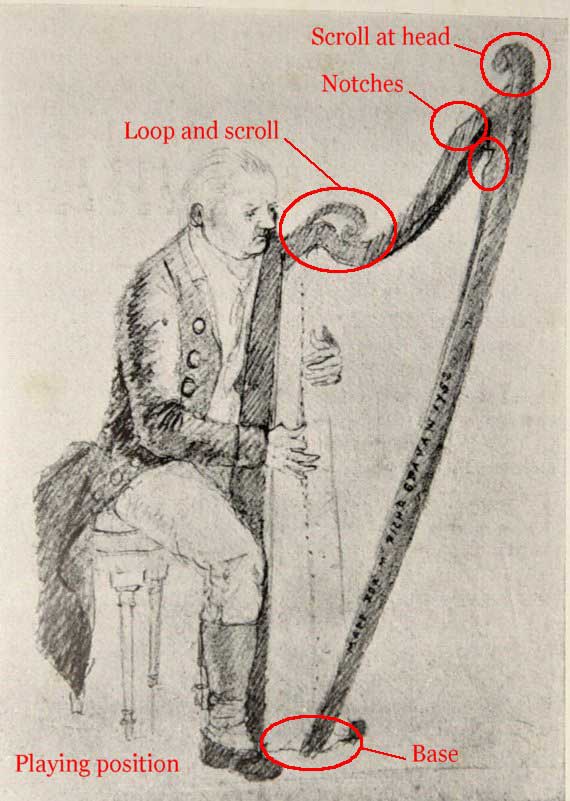
Charles Byrne’s harp. The specific areas of similarity to the Mulagh harp, here shown in red, are referred to in the text that follows.
Although not clearly delineated with a drawn outline or edge, the heavy shading of Miss Reilly’s sketch still manages to indicate the characteristic form of this unusual feature, one which is also found on the Mulagh. Although it would be incorrect to describe this as unique, it has only been found on one other harp (The Bunworth Harp) and depicted in only one other drawing (that of The Hehir Harp), so it is certainly uncommon.[14]
The carving of some sort of finial at the top of the forepillar, sometimes a figurehead but more often a scroll, could almost be said to be standard practice for Irish harps of the later 17th and 18th centuries. At first glance, the Mulagh today appears to have no scroll at all, but a closer look at the top of the pillar reveals the stub–remains where a scroll has broken off. A careful examination of these remnants indicates that the form of this scroll is consistent with that depicted in the sketch.[15]
Although, as mentioned above, the sketch indicates none of the smaller detail or decoration, it does show what could be described as notches in the harp’s outline in the area where the neck and forepillar join. These are interesting because they correspond with the positions on the Mulagh harp where two scroll patterns have been incised into the surface, and where the profile of the neck and pillar has been shaped to fit this decorative work. But it it when the Mulagh is viewed alongside the sketch, at the same angle, that the striking similarity of these individual and pronounced notches really becomes apparent, especially when comparing the outline or silhouette formed where the underside of the neck meets the back of the forepillar.
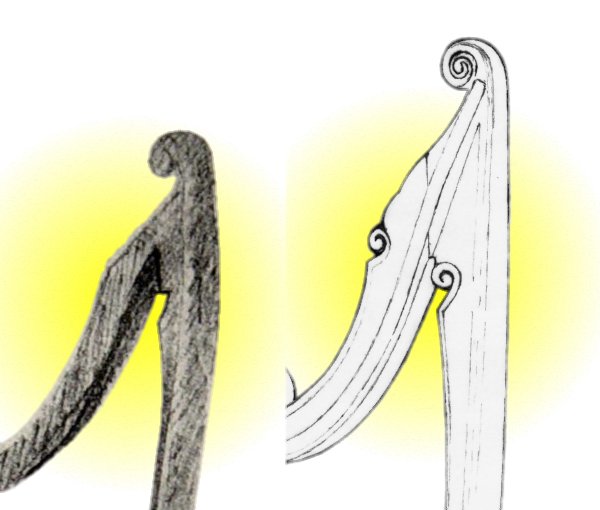
A comparison of the sketch of Byrne’s harp with the same view of the Mulagh harp, high–lighted to show the pronounced similarity of the distinctive silhouette.
Perhaps the most interesting aspect of the similarities between the Mulagh harp and the sketch concerns the base attached to the bottom of the soundbox, and the implications this has regarding the manner in which the harp would have been positioned and played. As mentioned above, it does seem to be unique, and it was this that prompted me to try to understand exactly how and why this highly unusual feature was added to the Mulagh.
For many years this attached base was recessed into a heavy plaster–block display stand, a situation which made it impossible to gain a full picture when I first looked at the harp in 2007. However the following year, at my request, the museum detached the harp from this stand and I was able to undertake a fuller examination. Because of its potential importance, I will deal with the base and related aspects in some detail.
Before beginning to describe it I should first point out that although it seemed apparent that this was unlikely to have been an original feature, it had clearly been in place for a considerable period of time. It was also fairly clear that this base had never been intended to function as a support stand, for the angle at which it was attached would not have put the harp into a stable balance, but would have made it topple forward.[16]
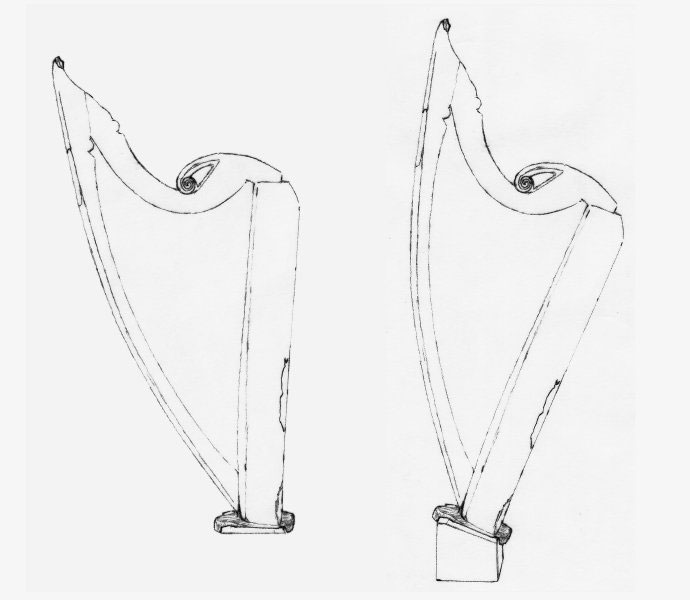
The Mulagh Mast harp leans forward and is unstable when positioned flat on the base, and so to achieve a better balance the museum’s plaster–block display stand had been formed with a sloping top
The base itself is made from a single piece of oak, about 35mm in thickness and somewhat crudely fashioned, with the whole thing lacking in any real attempt at symmetry. The front was carved into an irregular double curve whereas the sides were cut (sawn) straight.[17] To accommodate the projecting block at the end of the soundbox, a large rectangular hole was made through the middle, and to either side of this the upper surface has been hollowed with a gouge to form two recesses into which the curved ends of the soundbox fit. The base was then attached and secured firmly in position with two large countersunk screws that passed right through the lower end of the soundbox and protruded into the cavity of the box itself. After the base was attached, the end of the projecting block was then cut or sawn off flush with the underside, and here the end of the block appears to be in a somewhat decayed or friable state. There are indications of a major split in what remains of the block, but the decayed and friable nature makes it difficult to discern a hard edge to this.
Further examination of the area around the projecting block reveals more signs of damage and two interesting attempts at repair. Looking at the back of the harp, it can be seen that part of the block had been cut away before the base was attached. This on its own may not necessarily have been a problem, but it could be an indication that the block was beginning to break up in a more serious way. In what appears to be an attempt to reinforce the block, a thin iron band has been wrapped around it, close up against the end of the soundbox and just below the bottom of the forepillar; with the two ends of the band being joined by a clasp at the front. This band is now partly covered by the base, indicating that the band was already in position before the base was added.[18] There is also a crack running up the right–hand side of the projecting block and into the soundbox. This is also clearly visible on the inside of the box, where a thin sheet of tin–plate has been nailed across the split to strap the two sides together.[19]
Please click on the images to see a larger version of the pictures. You may then hover over the enlarged images to scroll through them. Please note: This feature works best on large screens, on a computer rather than a mobile device.
These photographs are reproduced courtesy of the National Museum of Ireland.
Regarding the question as to why this unusual base was added, there are two plausible possibilities. The first is that it was incorporated as part of a general repair to the bottom of the instrument, the intention being to further support the (presumably) weakened projecting block. The second is that it was done with the deliberate intention of enabling the projecting block to be shortened, thus reducing the height of the harp slightly. Even lowering the instrument by only one or two inches could have made an important difference to a physically small player like Byrne.
Having already mentioned the manner in which Charles Byrne appears to be supporting his harp whilst playing it in the sketch, and noted that this would have been necessary to prevent it from overbalancing forward, then the same logic would apply in the case of the Mulagh. Certainly with the Mulagh placed with its base flat on the floor, the centre of gravity is such that it will tend to topple forward if not similarly supported.
Although it takes time for significant amounts of wear to build up on an instrument, if Byrne did play the Mulagh for some years in the manner previously described, and as seen in the sketch, it is possible that the signs of wear associated with this playing position would be left on the harp.
As noted above, the way that Byrne appears to be gripping the harp shows three main areas of contact:
An examination of the Mulagh reveals that there are indeed indications of wear and damage which correspond with these areas:
As might be expected, patches of wear caused by the friction of the player’s arms rubbing against the sides of the soundboard can also be found. Here it is noticeable that the depression made by the lower (bass) hand on the right side is more pronounced than that caused by the upper (treble) hand on the left. This difference may simply have been the result of the way the arms happened to contact the box while playing, but it certainly indicates a greater degree of friction or pressure exerted on the right, and it could be that the right hand or wrist was also be used to steady the harp to some extent.[22]
Areas of wear on the soundbox
Please click on these images to see a larger version of the pictures. You may then hover over the enlarged images to scroll through them. Please note: this feature works best on large screens, on a computer rather than a mobile device.
These photographs are reproduced courtesy of the National Museum of Ireland.
These wear patterns are certainly in keeping with the suggestion that the Mulagh was held and played in the manner seen in the sketch of Charles Byrne. Since it’s probable that in its original form — before the base was added and the projecting block shortened — the Mulagh would have been played in a position similar to that described for the other old harps (i.e. with the soundbox tilted back to rest against the player’s chest), it seems likely that the specific nature of the wear and damage noted above came about as a result of altering the playing position to adapt to changes made to this harp.
One other unusual characteristic in the Mulagh soundbox is also worth mentioning as it may have relevance to this playing position. Unlike the majority of extant Irish harps, whose soundboxes are basically rectangular in section with the sides being at right–angles to the back, the cross–section of the Mulagh is somewhat trapezoidal. The sides angle inwards to meet the soundboard, meaning that the back of the box is wider than the front, resulting in a slightly acute angle at the back edge.[23] It is likely that this shape came about from the maker trying to get the maximum–sized box out of a trunk of limited diameter (see diagram); but the angled-in sides also make it easier to grip the box with the legs in the manner observed in the sketch of Byrne.[24]
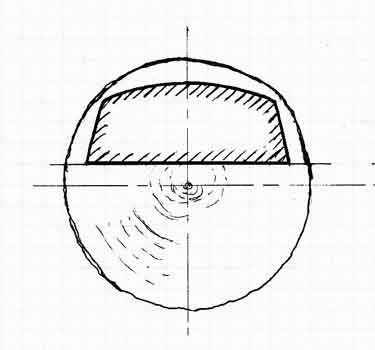
Diagram showing how the soundbox would have been positioned within the trunk of the tree.
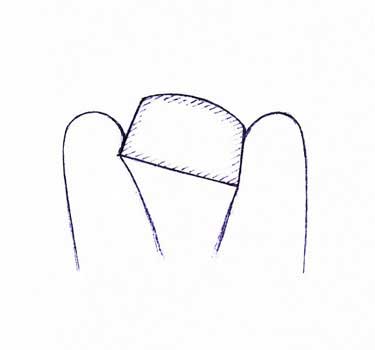
Diagram showing how the angled sides of the soundbox could be gripped by the legs in the manner suggested by the sketch of Charles Byrne.
Having examined the Mulagh harp in great detail and outlined the observations made in the comparative study above, there is little doubt in my mind that the harp Charles Byrne is seen playing in the sketch is the same instrument as that now known as the Mulagh, or Mulagh Mast, Harp. The balance of probability is strongly tipped in favour of these being the same, not only from their general appearance and marked common characteristics, but particularly in the addition of the base (an apparently unique feature) and the way in which the wear patterns concur with the unconventional playing position indicated in the sketch.
Of all the surviving Irish harps made prior to the 19th century, no two are the same. In light of this fact, it is difficult to imagine a plausible scenario whereby two separate harps played by two separate musicians would have so many unusual features and (as yet) unique aspects in common.
If it is accepted that the harp Charles Byrne is depicted as playing in 1810 is the Mulagh, and in view of the fact that it would have taken some time for this wear and damage to accrue, it is likely that Byrne used this instrument for a number of years. If so, there is a strong possibility that the Mulagh could have been the harp Byrne was playing at the historic Belfast Harp Festival in 1792. Of the ten harpers who attended this gathering, there is now strong evidence to connect four of them with harps that still survive. They are Charles Byrne (The Mulagh Harp), Arthur O’Neill (The Belfast Museum Harp), Patrick Quinn (The Castle Otway Harp), and Denis Hempson (The Downhill Harp).
As mentioned in the opening paragraph, Charles Byrne was thought to have been the second oldest of the ‘Belfast Harpers’ with only Denis Hempson being of greater age. Hempson was the sole performer to play with fingernails: Byrne and all the others used the fingertips, as had long been the normal practice by that time. The Mulagh and Downhill Harps may stand as links with the two oldest harpers at the Belfast meeting, itself the closing of a chapter.
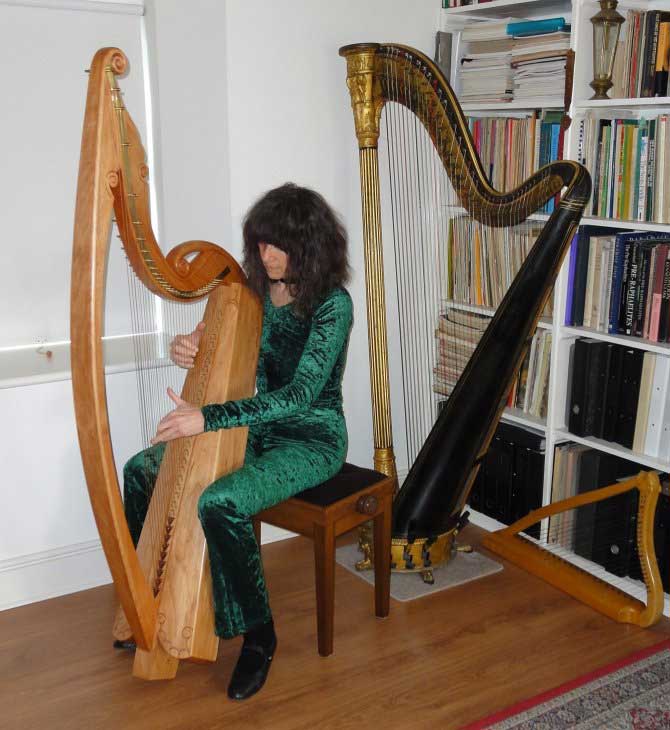
Before the oak base was added and the projecting block cut back, the Mulagh harp would more likely have been played with the soundbox leaned backwards to rest against the player’s chest. The replica of the Mulagh, seen here being played by Bonnie Shaljean, was reconstructed by the author to represent its earlier form.
I would like to thank the National Museum of Ireland and their staff, and especially Michael Kenny and Jennifer Goff, who have been of great assistance to my research over the last few years.
[1] This illustration is a photograph of a page from Charlotte Milligan Fox’s Annals of the Irish Harpers, 1911 (facing page 130). Before taking this photo, several different copies of the book were examined in order to obtain a reproduction with the highest quality of detail.
[2] Two separate accounts state that Charles Byrne was aged 80 when he attended the 1792 Belfast Harp meeting (see The Belfast News Letter, 13th July 1792, and Edward Bunting’s The Ancient Music of Ireland, 1840, p. 63). Yet this is contradicted by the information accompanying the sketch as reproduced in Annals of the Irish Harpers, op.cit., where Charlotte Milligan Fox has had the words “Aged 92” and “Sketched by Miss O’Reilly, of Scarva, 16th August 1810” printed directly below the sketch. There is no mention in the accompanying letter (see ref. 8 below) regarding his age or the date when the sketch was made, and Milligan Fox gives no indication as to where she obtained her information. A plausible suggestion is that it had been written lightly on the back of the original; but even this may not be much help when assessing his true age, for there is always the possibility that what Milligan Fox took to be 92 was the misreading of a faintly written 98.
[3] See The Memoirs of Arthur O’Neill, chapter 4, pp. 322–323; chapter 5, p. 356; and chapter 6, p. 329, printed in Donal O’Sullivan’s Carolan, The Life Times and Music of an Irish Harper, 1958 & 2001 (page numbers refer to the augmented Ossian Publications edition 2001).
[4] The Memoirs of Arthur O’Neill, op.cit., chapter 2, p. 316. It is generally assumed that Charles Byrne’s uncle was the same person as the “harper called Berreen that Carolan detested very much” (see The Memoirs of Arthur O’Neill, op.cit, chapter 3, p. 318) but, although this may seem a reasonable supposition, there are no contemporary accounts to support it. However, what is known of Charles Byrne’s repertoire certainly includes a good number of O’Carolan’s pieces.
[5] See, for example, Edward Bunting, op.cit., p. 77.
[6] Charlotte Milligan Fox, op.cit., pp. 135-136.
[7] Charlotte Milligan Fox, op.cit., p. 129. Although it is generally assumed that the majority of harpers in the 18th century were men, it was not uncommon for the instrument to be played by women to a high standard. The harper O’Neill mentioned in a letter to Sydney Owenson, “I remember in this neighbourhood fifteen ladies proficients on the Irish Harp; two in particular excelled, a Mrs. Bailly and a Mrs. Hermar; but all are now dead; so is Rose Moony, who was likewise celebrated. Fanning I knew, and thought well of his performance.” Sydney Owenson, The Wild Irish Girl, 1806, Chapter 1, Letter VII.
Mrs. Bailly is likely to be the same lady as Mrs. Bailie of Terrinaskea, Co. Tyrone, who “played on the harp very well” and for a while was a patron of the harper Charles Fanning. See The Memoirs of Arthur O’Neill, op.cit., chapters VII, p. 331.
[8] Charlotte Milligan Fox, op.cit., p. 130. Since the sketch was found with Bunting’s papers it is self–evident that Bunting failed to comply with the request made by James O’Reilly to return it to him. Bunting’s final work, The Ancient Music of Ireland, would have been nearly ready for publication by the time he received this letter and it may have been too late to incorporate this sketch into that volume. However, it is possible that Bunting may have decided to not return the sketch immediately, in the hope and intention of including it in a subsequent reprint. But Bunting died two years later and it remained with his papers; so it was left for Milligan Fox to finally bring this sketch to public attention in 1911.
[9] J. M. Reilly appears to be James Myles Reilly, the third son of the marriage of John Reilly and Jane Lushington. John O’Hart, in his Irish Pedigrees: Origin and Stem of the Irish Nation, 1880, p. 745, gives the names of James’ two brothers as John Lushington Reilly and William Edmond Reilly, but fails to note the names, or even the existence, of any sisters.
[10] This is the manner in which the name is carved on the front of the Downhill harp, and the maker’s name has been added to the back face of the pillar of the Dalway (a.k.a. Cloyne) harp in the same way. This logic, of aligning the text down the centre of the forepillar, is also demonstrated in the inscription carved in Irish down the front face of the pillar on the “Richard Hayward” harp (see Richard Hayward, The Story of The Irish Harp, 1954, p. 15).
[11] This instrument derives its current name from an old handwritten label pasted under the neck which states “This Harp found in Mulagh Mast County Kerry”. This label has been known about for a long time, but in more recent years the name has often been corrupted into ‘Mullaghmast’ and the implied assumption that this refers to the hill of that name in Co. Kildare is probably not correct. A more detailed study of this and other aspects of the Mulagh’s history will be examined further in another article. [see History of the Mulagh Mast Harp]
[12] My suggestion that the harp in the sketch is the same as the Mulagh was first raised in private correspondence with Keith Sanger, who in a letter to me of 20th October 1982 asked:
“Do you have any information about the ‘Mullagh Mast’? My interest is aroused by Russell–Ferguson’s ref. to the ‘Curragh Marsh’ having a label on it saying it was brought to Taymouth Castle from the Marquis of Breadalbane’s apartments in Holyrood Palace in 1860.”
In reply I wrote on 9th November 1982:
“On the subject of the Mullagh Mast harp, I have no more information than that from Joan Rimmer, except the enclosed picture of Charles Byrne from ‘Annals of the Irish Harpers’. It is a bit faint, since it is a copy of a copy, but the characteristic features are those of the Mullagh Mast harp and I would go so far as to stick my neck out and say that they were the same.”
[13] The observations on the Mulagh, or Mulagh Mast, were made as part of a program of detailed examination of harps at the National Museum of Ireland which I undertook between March 2007 and December 2011.
[14] For further comments on the “loop and scroll” feature see The Hehir Harp page (especially footnotes 6 and 7).
[15] It would seem that after the head scroll first broke off, an attempt was made to reattach it. Closer examination also revealed the remains of an iron nail which had been driven through the very top of the forepillar (from the front) into where the broken part of the scroll would have been. Refixing the scroll in this way may have proved a successful method, holding it in place for quite some time before it became detached again. It is therefore difficult to say at what stage in the harp’s life the scroll first broke away, or when it was finally lost.
[16] It is worth noting that in order for the harp to be held upright in a balanced position, the plaster–block display stand (to which the base was later attached) had to be deliberately formed with a sloping top. (see illustration above).
[17] It should be noted however that these cut sides as they are seen today do not represent the original form of the oak base, for the sides were re–cut after it was originally constructed. This is particularly evident on the left side where the timber of the cut side is much lighter in colour than on the rest of the base. Furthermore, the cutting has exposed tunnels of previous woodworm activity, indicating that this took place quite some time after the base was first made. It is also evident that this cutting back was done without the base being removed from the harp: a careful inspection revealed a corresponding nick in the end of the soundbox, made by the cutting tool.
Probably the most likely explanation for this later reshaping of the oak base is that it facilitates its incorporation into a separate display stand. Indeed, the harp may well have been fitted to other display stands of a form earlier than the plaster block that was found supporting it in 2007.
Evidence for this suggestion is provided by the existence of holes in the base (other than the those for the two screws used to attach it to the plaster–block) and by traces of what appears to be pale blue paint running in two bands across the underside of the base. The plaster–block display stand mentioned above was white in colour, so the pale blue would not have come from that. However, traces of this pale blue were also found on part of the cut–back timber, indicating that the paint came after the cutting or reshaping of the base had been done.
[18] The missing piece of block probably resulted from an earlier attempt at repair, whereby part of the decayed or damaged timber was cut away and a new piece of wood inserted. If so, this new piece had become detached before the iron band was added. A similar method of repairing a worn or damaged projecting block, by insetting a new piece of wood, was also found to have been used on the Downhill harp (personal observation by the author).
[19] Applying a metal strap across a crack on the inside of this part of the soundbox is by no means unusual, and this repair also appears on a number of other old harps. I observed this feature when examining the Kildare harp in 2008, and a similar strap was also fitted on the Downhill harp, where a “copper plate fastened with nails” was noted in a letter dated 24th April 1963 from William O’Sullivan (Keeper, Art and Industrial Division) to Leslie Luke Esq. of Guinness (Guinness Archive, file GDB/CO04.04/0014). N.B. The strap on the Downhill was subsequently removed but the nail holes remained.
[20] Damage is often found on the older harps at the edge of the soundbox where the back is attached. This is especially true where the back board is recessed (or rebated) into the sides of the box, as on the Mulagh. The reason is that using this method greatly reduces the thickness of the timber along the back edge, and in consequence it is weakened, becoming more vulnerable to knocks and pressure.
[21] This area of wear is also clearly visible on the old National Museum of Ireland black and white photograph reproduced above.
[22] One interesting observation concerning the areas of wear found on the soundbox (particularly noticeable on the right side) is that the erosion of the surface exposed old tunnels made by woodworm. This is a clear indication that the tunnels were already there in the box before the wear took place, i.e. that woodworm was attacking the harp from an early stage, before it had been played to any great extent.
[23] The sides of the Sirr harp’s soundbox also angle inwards slightly from the back towards the front, though this is not nearly as pronounced as on the Mulagh, and only really becomes apparent towards the top end.
[24] This was previously suggested in an unpublished report I wrote after making an examination of the Mulagh Mast harp at the National Museum of Ireland, titled Harp Photographs March 2007 — A Report by Michael Billinge, subheaded Further Notes on the Mulagh Mast Harp:
“The soundbox has been shaped in a manner [such that]... the cross–section of the box is not rectangular but trapezoidal, which means that the back of the box is wider than the front by an inch or so. One possible explanation for this uncommon form is that the maker may have been trying to get the largest box he could from a tree trunk of limited size. The box would need to have been cut from one half of the trunk (it distorts and splits if cut from the centre of the tree)... However this shape may have been a deliberate design choice, because it does facilitate a particular manner of supporting the harp while playing.”
© 2012 by Michael Billinge
Submitted by Michael Billinge, 29 October, 2012
The black and white photograph of the Mulagh Mast harp is reproduced with the permission of the National Museum of Ireland, in whom the copyright vests. All other illustrations copyright ©2012 Michael Billinge. All photographs of the Mulagh harp are reproduced courtesy of the National Museum of Ireland.
Except where otherwise noted, content on this site is licensed under a Creative Commons License.
Permissions beyond the scope of this license may be available by contacting us at editor@wirestrungharp.com.
